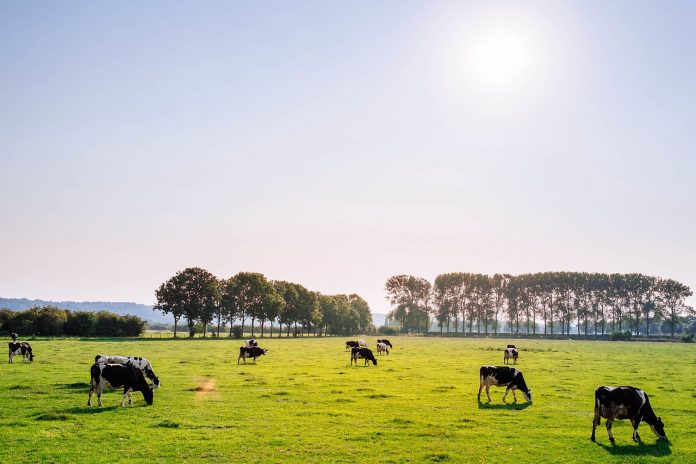I am sure everyone is aware that spring is already here, some would even argue that it came a bit early. One indicator of this can be seen when you examine the growing degree days that many farmers utilize for planting as well as pest management.
The growing degree days are higher in 2023 at this time than they were in 2022. We can also see the green-green grass starting to grow out there. The cattle are also probably starting to get sick of that old hay they have been chewing on all winter, probably while covered in mud!
What’s going on
So, if we examine what is going on with the grass right now, we will notice that they are pulling up potassium from the ground and growing as much leaf surface area as they can, in order to make the transition out of dormancy. The leaves are greening up and chlorophyll production is in full swing.
The plant is not very tall yet, so lignin is not a major factor. Lignin is the substance that is indigestible to livestock and allows the plant to remain upright and rigid. A suitable example is grass with seed heads. What we have out right now is high-nutrient, low-fiber forage that the cows are eyeing up and waiting for that fence to come down.
Now let’s examine what is going on inside the cow’s rumen. Rumen bacteria are responsible for digesting feed. Rumen bacteria digest feed by attaching to the feed particles and releasing enzymes. In addition to the bacteria, there are rumen protozoa that swallow soluble sugars and starch. There are normally around 1 to 10 million protozoa per milliliter of rumen contents.
There are also rumen fungi, which number in the tens of thousands per ml of rumen contents. These fungi are responsible for breaking the lignin-hemicellulose bonds of forages, making more cellulose available to the rumen bacteria. With a forage-based diet, there are approximately 1 to 3 billion bacteria per ml of rumen contents. What I am getting at here is the rumen will balance itself for the diet that it is dealing with. A major shift in diet can cause imbalances such as gas production or mineral biochemical issues.
Issues to watch
Grass tetany is a magnesium disorder typically seen early in the spring. It happens when the magnesium levels are below 0.2% in the forage. It makes sense that a low magnesium diet can cause magnesium deficiency, but sometimes the magnesium levels can be above 0.2% and magnesium deficiency can still occur.
The most typical reason for this is because of potassium. There are times when the potassium levels are so high in the forage that it prevents magnesium from being taken up from the rumen to the bloodstream. What we want to see in a forage analysis in this case is levels of potassium that are below 3%. Grasses in rapid spring growth will take up a lot of potassium, so manure applications at this time would be at greater risk for high potassium forage that can lead to grass tetany.
Symptoms of grass tetany include decreased milk production, nervousness/restlessness, twitchy skin, staggered gait and collapse with stiffness. If you notice this, call a veterinarian. That animal will probably need an injection of magnesium sulfate. Preventative measures include:
- Having a high magnesium (8-12%) mineral available.
- Do not over-apply Potash in pastures.
- Legumes and forbs are high in Mg, maintain a 30% legume ratio in pastures.
- Limit grazing on early spring pastures especially if the cow was fed Mg-deficient hay in winter.
- Observe the older lactating cows for symptoms.
Bloat is the other big concern in early spring grazing. Bloat is caused by gases that build up pressure in the rumen and are unable to escape. Remember the sensitive and balanced rumen flora previously mentioned. Pasture bloat typically occurs on cattle grazing on lush forage that is low in fiber and high in total digestible nutrients. Many times, we see this in immature legume pastures. Alfalfa and clovers have a high bloat potential.
Some high-risk practices that can lead to bloat are:
- Hungry cattle released on legume pastures that are greater than 50% legumes or fed high legume hay.
- Frost, dew or rain on fields can also increase the risk of bloating (creates foam).
- Sudden switch from poor quality feed to high nutrition-legume diet.
Some preventative measures you can take to reduce the risk of bloat are to start grazing in paddocks that are richer in grasses than legumes. Feed hay before allowing animals to feed on fresh pasture. Another good idea is to wait until the forage is dry before releasing animals.
Go slow
In anything you do with livestock, rapid change, even for improvements, can be risky. Cattle like to move slowly so transition them slowly as well. Try not to go from “0 to 60”, especially with forage quality. Keep your eye on livestock that are at higher risk for tetany and bloat. Check the field for adequate minerals and be aware of what is growing out there. Try to stay one step ahead so you see it before your herd does.












